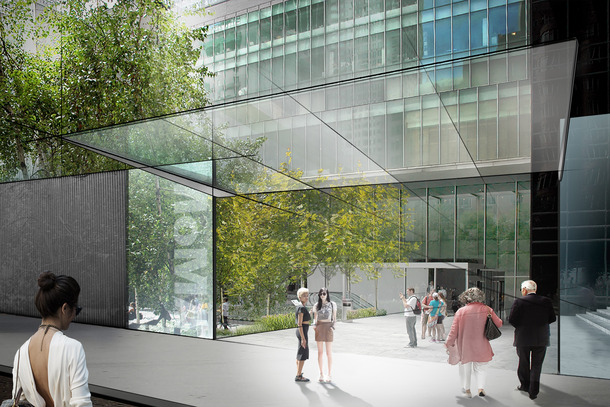Tears never welled when I read about MoMA’s expansion plan. Maybe that’s because I wasn’t forced to sit through yesterdays press preview, which was reportedly three hours of blathering architects, (they’re the only profession whose jargon can make artspeak sound perfectly intelligible), but I also dislike the Folk Art Museum design enough that anything new sounds attractive. The building was a modernist nightmare that was not only at odds with the museum’s collection, but also left little room for it to be viewed.
The building may well have been at the root of the museum’s fiscal problems, which ultimately could not be solved. The intitution, once a lavish venue for under-recognized artists, declared bankruptcy and was purchased by MoMA, a museum in the form of 6 story high corporate lobby.
So perhaps it’s not too surprising that the acquisition and redesign of the Folk Art Museum comes at the expense of its soul. In place of the Folk Museum’s famed armor like facade, Diller Scofidio & Renfro have proposed an “Art Bay” encased in glass, a space that should already be familiar to visitors of MoMA. Back in 2006, I was among many art bloggers who brainstormed solutions for MoMA’s similarly conceived Atrium space, an enormous white bucket that the museum dropped bits of art into from time to time. This year, we’re complaining that they’ll be replicating the problem. It seems MoMA’s need to display three-story art has superseded their desire to find a home for their outsized permanent collection.
I’m not thrilled with this, but it’s not exactly a surprise either. I stopped regularly visiting the museum nearly two years ago because I grew tired of their anodyne space and hit-and-miss programming. After a while, the allure of seeing continuous new acquisition shows and Cindy Sherman blockbusters dims.
I expect the renovation will give me a few more reasons to attend, though, at least initially. I like MOMA’s growing focus on performance art (though I worry that will translate into pop star programming), and the additional 30,000 square feet of exhibition space will give them a chance to add more depth to their program. Most important in my book, though, is that Diller Scofidio & Renfro have addressed the issue of the 53rd Street entrance, which is entirely elusive. I’ve ended up in MoMA’s restaurant and theater more times than I can count simply for walking in the wrong door. If I find myself lost and in The Modern at the end of all this, I’ll be an unhappy critic.



Comments on this entry are closed.